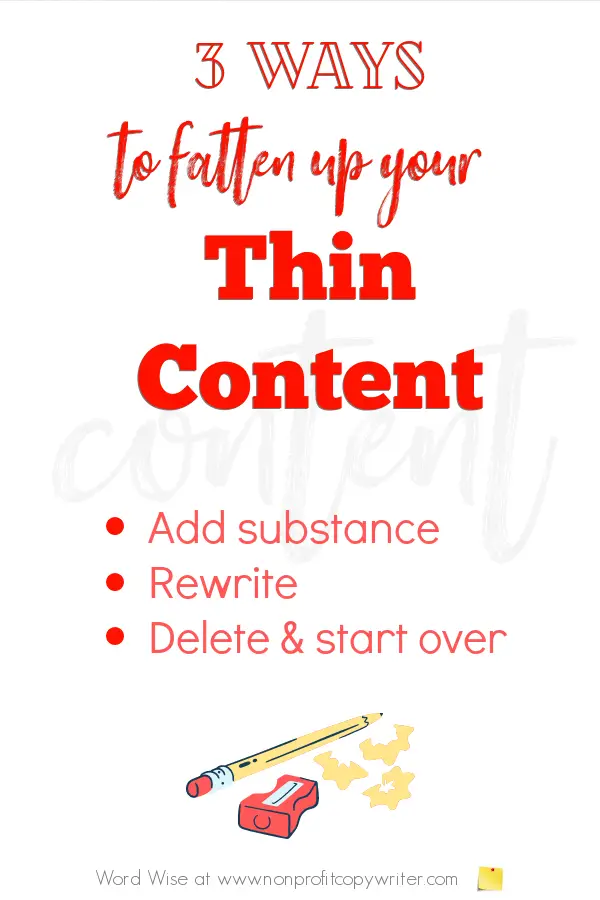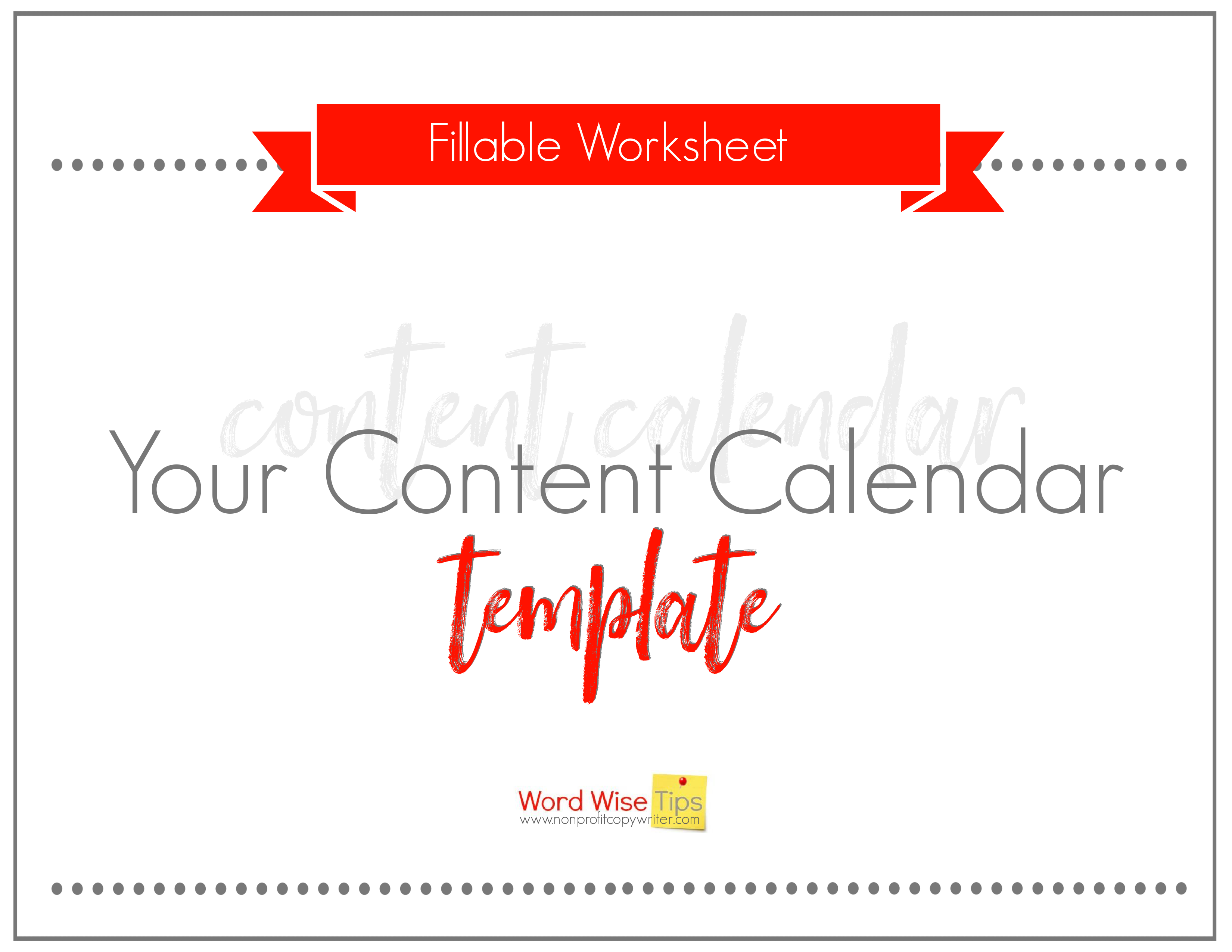Save Time: Get 5 Simple Writing Tips
you can put to use in 10 minutes
The Skinny on Thin Content: Don’t Put Rankings Over Readers
Award-winning writer Kathy Widenhouse has helped hundreds of nonprofits and writers produce successful content , with 750K+ views for her writing tutorials. She is the author of 9 books. See more of Kathy’s content here.
Updated 8.21.25
In your impatience to build new pages on your site and get traffic, you may have generated a problem: thin content.
True, you may have created this problem unknowingly. You want more readers to find your website or blog. So, you took a logical first step recommended by writers everywhere by studying well-ranked pages in your niche – ones that address a similar topic as your post-in-progress.
If you mimicked other successful online writers, you reasoned, your page or post could compete with theirs. You’d move up in the rankings and get more traffic, right? Your next steps followed: you added extra keywords to your page. You padded the content a bit and threw in several extra links. Now your post or page is as long or longer than that of your competitors.
The problem is your concern for your rankings over your readers. And your solution to that problem – keyword stuffing and padded content over substance – doesn’t help. Your solution simply creates thin content.
What is thin content?
Thin content has little or no value for your reader. It leaves users hungry to answer their question or provide information they need, thereby breaking a writer’s cardinal rule: putting the reader first.
Quality content, on the other hand, provides information that is relevant or useful for the reader. Users go away satisfied, either in part or in full.
Search engines give thin content a big thumbs down.
That negative impression shows on results pages. Pages with thin content have less chance of appearing on an online writer’s Holy Grail – page 1 of your keyword’s search engine results.
It would be nice to have a magic formula that quantifies thin content using data, such as “anything shorter than XXX words.” And truthfully, posts and pages should contain at least 300 words to avoid a deep six from Google. Yet 3,000 words or more does not guarantee a “quality content” label, because length does not determine quality.
Quality content is as long as it needs to be in order to cover your subject. Sometimes that’s 300 words. Sometimes it’s 3,000 words.
Apart from length, a few factors are a tip off that your content is on the skinny side and needs some word calories. Use these three guidelines to check your content for substance. In doing so you place your readers over rankings. And as a happy consequence, your rankings will go up, too.
3 signs your content is too thin
1. Value
Quality content provides value. Thin content – not so much.
“Websites and pages should be created to help users,” says Google in its Search Quality Raters Guidelines, the instructions that human raters use to evaluate websites. If your site’s sole intent is to make money, search engines know it. Their handy-dandy algorithms are updated regularly to make sure users get the best results.
Look at your content from the user’s point of view.
As you create a page on your website, identify the problem or question it addresses for your reader. Does your content provide helpful information about that topic? Your page or post needn’t be exhaustive to be useful. It simply needs to be relevant, detailed, or information rich.
Let’s say your site offers information about office products. A user won’t find much value in a page that simply displays images of file cabinets and links to buy them. But a page that outlines what to look for when you’re choosing file cabinets? When you’ve been tasked by your boss with outfitting a new office, this information is relevant and helpful. Or perhaps you’ve written page with specific information about the open-close mechanisms used in file cabinet drawers. A reader whose file cabinet drawers get stuck regularly finds this page extremely valuable.
2. Originality
Quality content is original or unique. Thin content is hackneyed or trite. Yet “There is nothing new under the sun,” according to King Solomon, the wisest man who ever lived. That’s frustrating for writers. If there’s nothing new out there, how can we produce original content?
The truth is that writers are packagers. Your originality lies in how you arrange the information you collect.
Just as different people collect different kinds of tissue paper and gift bags and bows and boxes to wrap gifts, writers gather different kinds of information about a topic. You pour it through your own personal sieve to arrange it differently than others do, wrapping it in your unique voice. You may emphasize one idea … offer a new twist … expound on a different point of view … present a unique combination of facts and illustrations. It’s your packaging that what makes your content original and unique.
Thin content, however, doesn’t do the hard work of gathering and processing and packaging. It lacks an original voice. Instead, thin content is skimmed from other sites, often using the same language, wrongly assuming that “this site is successful, so I simply need to copy it or simulate it.”
3. Clarity
Quality content makes sense to the average user. Pages get marked as “thin” when they’re confusing to read. One of the best ways to check your content for quality is to read it aloud. When your language sounds stilted or confusing or repetitive or too formal, it’s time to change it.
Keywords are a key culprit. If you’re more intent on stuffing keywords into your content than in communicating helpful information, your page may have wordy, repetitive sentences like this: “Use a thin content checker to check your thin content SEO and avoid the Google thin content penalty.”
Or your skinny pages may rely on too many images and links with too little substantive text. Readers get confused and wonder, “What’s the point?” Search engines are smarter than that. So are readers.
Plan and track your content using this fillable and re-usable Content Calendar Template
How to fatten up your thin content
Add substance
Study the content on your page to make sure you’ve identified the specific topic to address. Choose just one focus. What’s the question, issue, problem, difficulty, story, subject, or event? How will your page solve, report, explain, inform, describe, or help? Drill down to be as specific as you can.
Rewrite it
Do a little more research … add examples … flesh out viewpoints … cite experts … report extra facts. Check your language. Use your page’s main keyword about once for every 100-200 words on the page and in at least one subhead, but only as a logical part of the content. If you need to lose a few keywords, do so – and relax. Include links naturally in the text, rather than packing your page with nonsensical affiliate links or links that don’t make any sense.
Delete it and start over
Let’s say you’ve got a page with inconsequential content. Or it’s packed with images and links but contains very little information. When you ask yourself the underlying question, “Will the user find this relevant or useful?” the answer is no.
Offer better quality to your readers. Go ahead and hit the delete key. And start over.
Concentrate on producing quality information that your readers need, and you’ll shed thin content. But you won’t put on frivolous extra weight in its place. You’ll add substance that readers notice. And search engines will, too.
More Content Writing Tips
A Simple Content Calendar Template for Bloggers and Solopreneurs ...
4 Types of Content: The Magic Is In the Mix ...
What Is SEO Content Writing? Use These Tips for Strong Search Results ...
The Case for Short vs. Long Form Content ...
Content Writer vs Copywriter: What’s the Difference?
Reach More Readers With Repurposed Content ...
How Keywords Work: an overview ...
6 places to use keywords in web pages and blog posts ...
Contextual Links and Why You Need Them on Your Website ...
The 3 Types of Links Your Website Needs and How to Build Them ...
Long Tail Keywords: A Quick Guide to Using Unpopular Search Terms ...
More Online Content Writing Tips on our Pinterest board ...
Return from The Skinny on Thin Content to Nonprofit Copywriter home
As an Amazon Associate I earn from qualifying purchases.
Share This Page

Named to 2022 Writer's Digest list
BEST GENRE/NICHE WRITING WEBSITE


Stop Wasting Time!
Grab your exclusive FREE guide, "5 Simple Writing Tips You Can Put to Use in 10 Minutes or Less"













